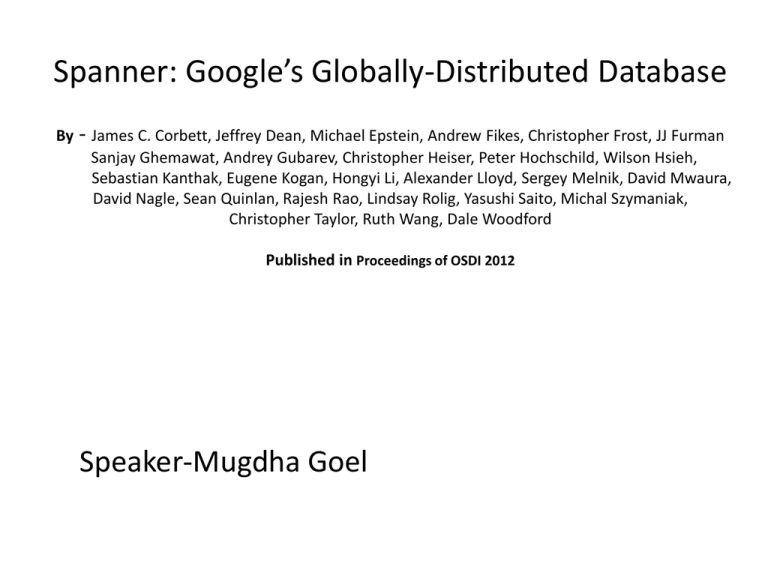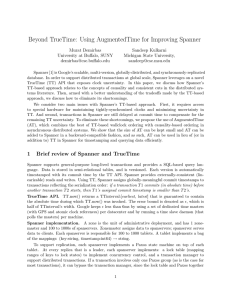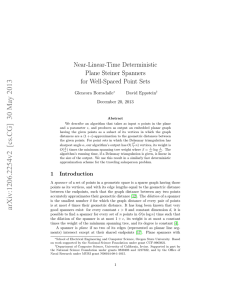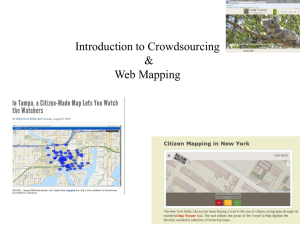30_Goel_Spanner
advertisement

Spanner: Google’s Globally-Distributed Database
By
- James C. Corbett, Jeffrey Dean, Michael Epstein, Andrew Fikes, Christopher Frost, JJ Furman
Sanjay Ghemawat, Andrey Gubarev, Christopher Heiser, Peter Hochschild, Wilson Hsieh,
Sebastian Kanthak, Eugene Kogan, Hongyi Li, Alexander Lloyd, Sergey Melnik, David Mwaura,
David Nagle, Sean Quinlan, Rajesh Rao, Lindsay Rolig, Yasushi Saito, Michal Szymaniak,
Christopher Taylor, Ruth Wang, Dale Woodford
Published in Proceedings of OSDI 2012
Speaker-Mugdha Goel
What is Spanner?
• It is a system to distribute data at a global scale and
support externally consistent distributed transactions.
• With Spanner, Google can offer a web service to a
worldwide audience, but still ensure that something
happening on the service in one part of the world
doesn’t contradict what’s happening in another.
• It automatically migrates data across machines and
data centers to balance load in case of failures.
• Scalable, Multi-version, and synchronously-replicated
database.
Need and Evolution
•
•
•
•
•
•
•
•
•
Spanner was made for high availability.
Need for consistent data across the globe.
Read and write without being crushed by huge latencies.
Having data located as per the Clients need.
Evolution
Spanner has evolved from a Bigtable-like versioned key-value store into a
temporal multi-version database.
Spanner is the successor to Google's Megastore system.
Data is stored in Semi-relational tables and handles faster read-writes.
Google's 'F1' advertising backend is using Spanner.
Gmail, Picasa, Google Calendar, the Android Market and its
AppEngine cloud all use Megastore, making them potential candidates for
a Spanner upgrade.
Features
• The replication configurations for data can be
dynamically controlled at a fine grain level by
applications and this process is transparent.
• Applications can control the location of data.
• Provides externally Consistent Read-writes.
• Provides globally consistent reads across the
database at a timestamp.
• Provides an implementation of the TrueTime
API.
Implementation
Spanserver Software Stack
• BigTable based implementation has following mapping:
(key:string, timestamp:int64) -> string
Spanner’s Data Model
• Need for Schematized Semi-relational tables and synchronous replication
- Megastore (replication,despite its relatively poor write throughput).
• A semi-relational data model which provides support for synchronous
• Need for an SQL like query language – Dremel(an interactive data analysis
tool)
• 2 phase commit had availability problems in Bigtable. Paxos mitigates the
problems.
• Underneath uses a Distributed File system known as Colossus.
Structure
• An application creates one or more databases in a universe.
• Each database can contain an unlimited number of schematized tables.
• Every table has an ordered set of one or more primary-key columns.
• Primary keys form the name for a row.
• Table defines a mapping from the primary-key columns to the nonprimary-key columns.
Example
CREATE TABLE Users {
uid INT64 NOT NULL, email STRING
} PRIMARY KEY (uid), DIRECTORY;
CREATE TABLE Albums {
uid INT64 NOT NULL, aid INT64 NOT NULL,
name STRING
} PRIMARY KEY (uid, aid),
INTERLEAVE IN PARENT Users ON DELETE CASCADE;
TrueTime
Method
Returns
TT.now()
TTinterval: [earliest; latest]
TT.after(t)
True if t has definitely passed
TT.before(t)
True if t has definitely not arrived
TTinterval - Interval with bounded time uncertainty(Endpoints are of TTstamp type).
tabs(e) – denotes absolute time for an event e.
for an invocation enow,
tt = TT.now(),
tt.earliest <= tabs(enow) <= tt.latest
Concurrency Control
Spanner supports:
• Read only transactions –
- Predeclared as not having any writes.
- Not simply a read-write transaction without any writes.
- Reads execute at a system-chosen timestamp without
locking, so that incoming writes are not blocked.
• Read-Write transactions
- Writes that occur in a transaction are buffered at the client until
commit.
• Snapshot reads
- Client chooses a timestamp for the read
- OR Client specifies an upperbound on the timestamp’s staleness.
Evaluations
Microbenchmarks
Two-phase commit scalability. Mean and
standard deviations over 10 runs.
Availaibility
Effect of killing servers on throughput
TrueTime
Distribution of TrueTime values
F1
F1-perceived operation latencies
F1’s transition
• F1’s backend was originally based on MYSQL.
• Disadvantages of using MYSQL
– It manually Sharded data.
– The MySQL sharding scheme assigned each customer and all related data to a fixed
shard.
– Extremely costly with increasing customers.
– Resharding was a very complex process which took about 2 years.
• Advantages of Spanner
– Spanner removes the need to manually reshard.
– Spanner provides synchronous replication and automatic failover. With MySQL masterslave replication, failover was difficult, and risked data loss and downtime.
– F1 Requires strong transactional semantics.
Future Work
• Google’s advertising backend was transitioned from MySQL
to Spanner.
• Currently working on Spanner’s schema language,
automatic maintenance of secondary indices, and
automatic load-based resharding.
In Future,
• Optimistically doing reads in parallel.
• Plans to support direct changes to paxos configurations.
• Improve single node performance by improving algorithms
and data structures.
• Moving data automatically between datacenters in
response to changes in client load.











